SAAB 9-3 2006 Owner's Guide
Manufacturer: SAAB, Model Year: 2006, Model line: 9-3, Model: SAAB 9-3 2006Pages: 318, PDF Size: 28.05 MB
Page 31 of 318
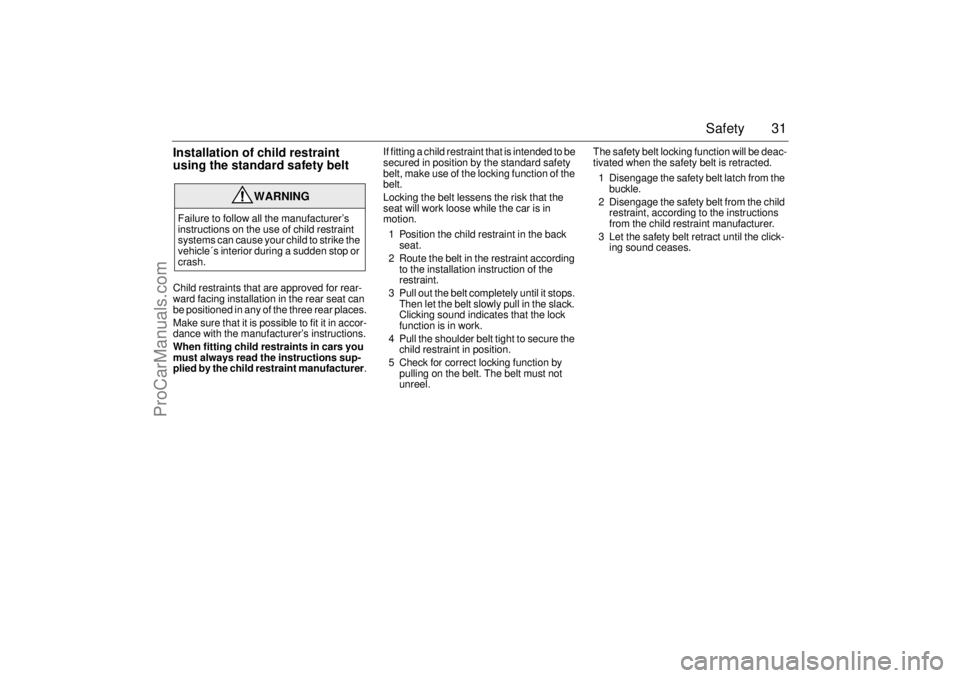
31 Safety
Installation of child restraint
using the standard safety beltChild restraints that are approved for rear-
ward facing installation in the rear seat can
be positioned in any of the three rear places.
Make sure that it is possible to fit it in accor-
dance with the manufacturer’s instructions.
When fitting child restraints in cars you
must always read the instructions sup-
plied by the child restraint manufacturer.If fitting a child restraint that is intended to be
secured in position by the standard safety
belt, make use of the locking function of the
belt.
Locking the belt lessens the risk that the
seat will work loose while the car is in
motion.
1 Position the child restraint in the back
seat.
2 Route the belt in the restraint according
to the installation instruction of the
restraint.
3 Pull out the belt completely until it stops.
Then let the belt slowly pull in the slack.
Clicking sound indicates that the lock
function is in work.
4 Pull the shoulder belt tight to secure the
child restraint in position.
5 Check for correct locking function by
pulling on the belt. The belt must not
unreel.The safety belt locking function will be deac-
tivated when the safety belt is retracted.
1 Disengage the safety belt latch from the
buckle.
2 Disengage the safety belt from the child
restraint, according to the instructions
from the child restraint manufacturer.
3 Let the safety belt retract until the click-
ing sound ceases.
WARNING
Failure to follow all the manufacturer’s
instructions on the use of child restraint
systems can cause your child to strike the
vehicle´s interior during a sudden stop or
crash.93U S M 06.book Page 31 Friday, February 18, 2005 1:15 PM
ProCarManuals.com
Page 32 of 318
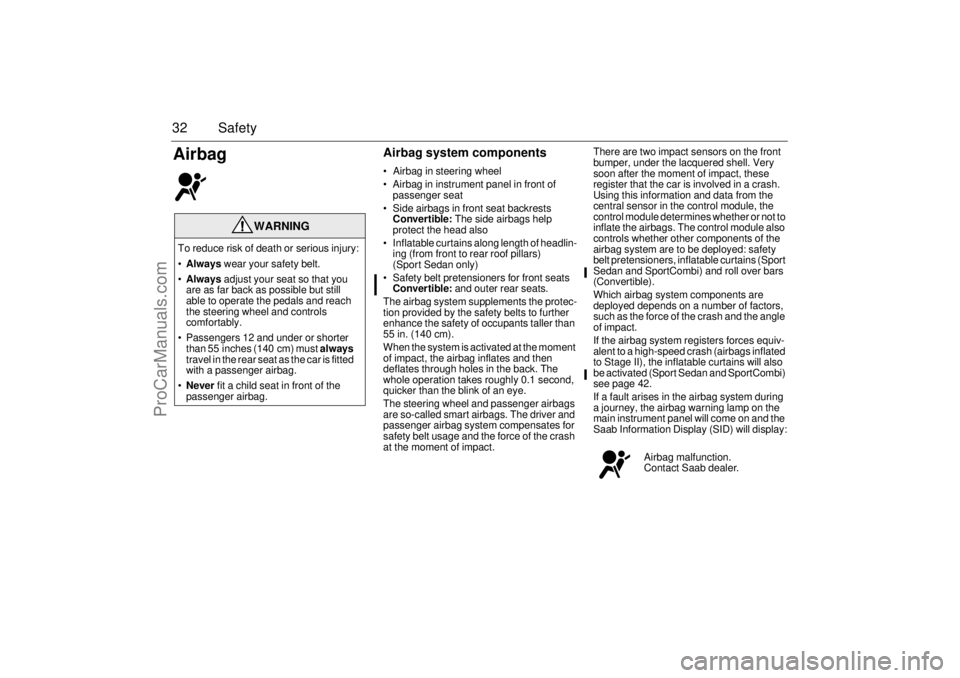
32 SafetyAirbag
Airbag system components Airbag in steering wheel
Airbag in instrument panel in front of
passenger seat
Side airbags in front seat backrests
Convertible: The side airbags help
protect the head also
Inflatable curtains along length of headlin-
ing (from front to rear roof pillars)
(Sport Sedan only)
Safety belt pretensioners for front seats
Convertible: and outer rear seats.
The airbag system supplements the protec-
tion provided by the safety belts to further
enhance the safety of occupants taller than
55 in. (140 cm).
When the system is activated at the moment
of impact, the airbag inflates and then
deflates through holes in the back. The
whole operation takes roughly 0.1 second,
quicker than the blink of an eye.
The steering wheel and passenger airbags
are so-called smart airbags. The driver and
passenger airbag system compensates for
safety belt usage and the force of the crash
at the moment of impact.There are two impact sensors on the front
bumper, under the lacquered shell. Very
soon after the moment of impact, these
register that the car is involved in a crash.
Using this information and data from the
central sensor in the control module, the
control module determines whether or not to
inflate the airbags. The control module also
controls whether other components of the
airbag system are to be deployed: safety
belt pretensioners, inflatable curtains (Sport
Sedan and SportCombi) and roll over bars
(Convertible).
Which airbag system components are
deployed depends on a number of factors,
such as the force of the crash and the angle
of impact.
If the airbag system registers forces equiv-
alent to a high-speed crash (airbags inflated
to Stage II), the inflatable curtains will also
be activated (Sport Sedan and SportCombi)
see page 42.
If a fault arises in the airbag system during
a journey, the airbag warning lamp on the
main instrument panel will come on and the
Saab Information Display (SID) will display:
WARNING
To reduce risk of death or serious injury:
Always wear your safety belt.
Always adjust your seat so that you
are as far back as possible but still
able to operate the pedals and reach
the steering wheel and controls
comfortably.
Passengers 12 and under or shorter
than 55 inches (140 cm) must always
travel in the rear seat as the car is fitted
with a passenger airbag.
Never fit a child seat in front of the
passenger airbag.
Airbag malfunction.
Contact Saab dealer.
93U S M 06.book Page 32 Friday, February 18, 2005 1:15 PM
ProCarManuals.com
Page 33 of 318

33 Safety
The driver and passenger front airbags are
triggered by violent front-end crashes. They
are not activated by minor front-end
impacts, if the car overturns or by rear- and
side-impacts.
The car is equipped as standard with
a passenger airbag.Note:
Impact sensors react differently depending
on whether or not the front safety belts on
the driver’s and passenger sides are used.
Situations can therefore arise where only
one of the airbags inflates. It is also possible
for only the safety belt pretensioners to be
activated and for the airbags to remain unin-
flated.
If only Stage I is activated at the moment of
impact, Stage II will automatically be acti-
vated later to neutralize the gas generator in
the airbag.
Both front airbags inflated
Inflated airbag (driver’s side).
Inflation and deflation of airbag takes
approx. 0.1 s93U S M 06.book Page 33 Friday, February 18, 2005 1:15 PM
ProCarManuals.com
Page 34 of 318

34 SafetyAirbag system1 Steering wheel with integral airbag
2 Passenger airbag
3 Side airbag
4 Inflatable curtain (Sport Sedan and SportCombi)
5 Sensors in front bumper
6 Sensor, side-impact protection
7 Sensor, side-impact protection (Sport Sedan and SportCombi)
8 Electronic control module and central sensor (SDM)
Accessories and other equipment must
not be fitted to the surfaces marked as
these are where the airbags inflate in the
event of a crash.
93U S M 06.book Page 34 Friday, February 18, 2005 1:15 PM
ProCarManuals.com
Page 35 of 318
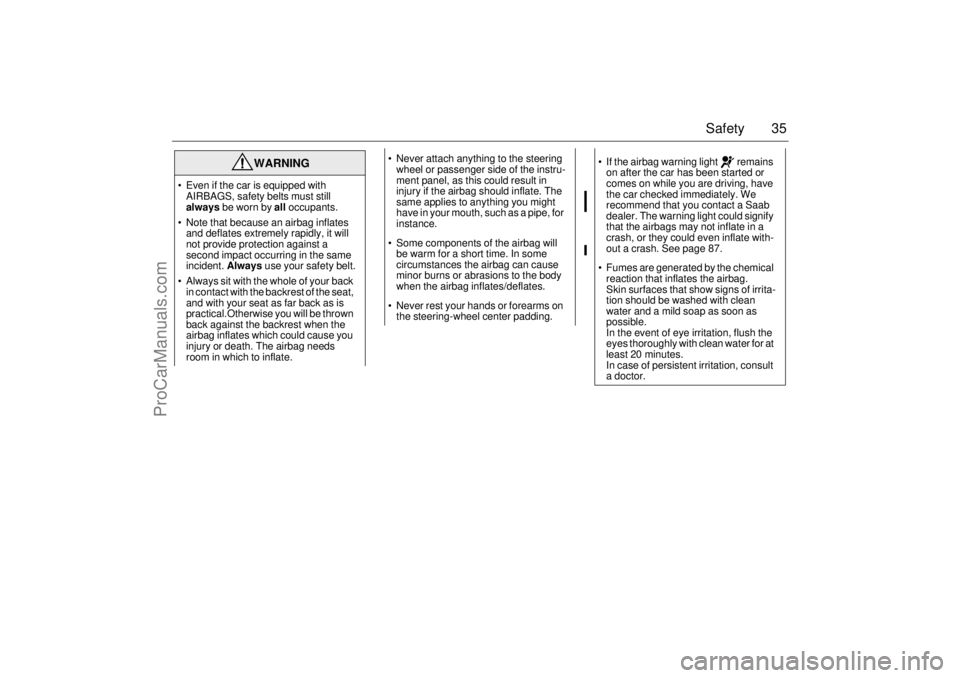
35 Safety
WARNING
Even if the car is equipped with
AIRBAGS, safety belts must still
always be worn by all occupants.
Note that because an airbag inflates
and deflates extremely rapidly, it will
not provide protection against a
second impact occurring in the same
incident. Always use your safety belt.
Always sit with the whole of your back
in contact with the backrest of the seat,
and with your seat as far back as is
practical.Otherwise you will be thrown
back against the backrest when the
airbag inflates which could cause you
injury or death. The airbag needs
room in which to inflate.
Never attach anything to the steering
wheel or passenger side of the instru-
ment panel, as this could result in
injury if the airbag should inflate. The
same applies to anything you might
have in your mouth, such as a pipe, for
instance.
Some components of the airbag will
be warm for a short time. In some
circumstances the airbag can cause
minor burns or abrasions to the body
when the airbag inflates/deflates.
Never rest your hands or forearms on
the steering-wheel center padding.
If the airbag warning light remains
on after the car has been started or
comes on while you are driving, have
the car checked immediately. We
recommend that you contact a Saab
dealer. The warning light could signify
that the airbags may not inflate in a
crash, or they could even inflate with-
out a crash. See page 87.
Fumes are generated by the chemical
reaction that inflates the airbag.
Skin surfaces that show signs of irrita-
tion should be washed with clean
water and a mild soap as soon as
possible.
In the event of eye irritation, flush the
eyes thoroughly with clean water for at
least 20 minutes.
In case of persistent irritation, consult
a doctor.
93U S M 06.book Page 35 Friday, February 18, 2005 1:15 PM
ProCarManuals.com
Page 36 of 318
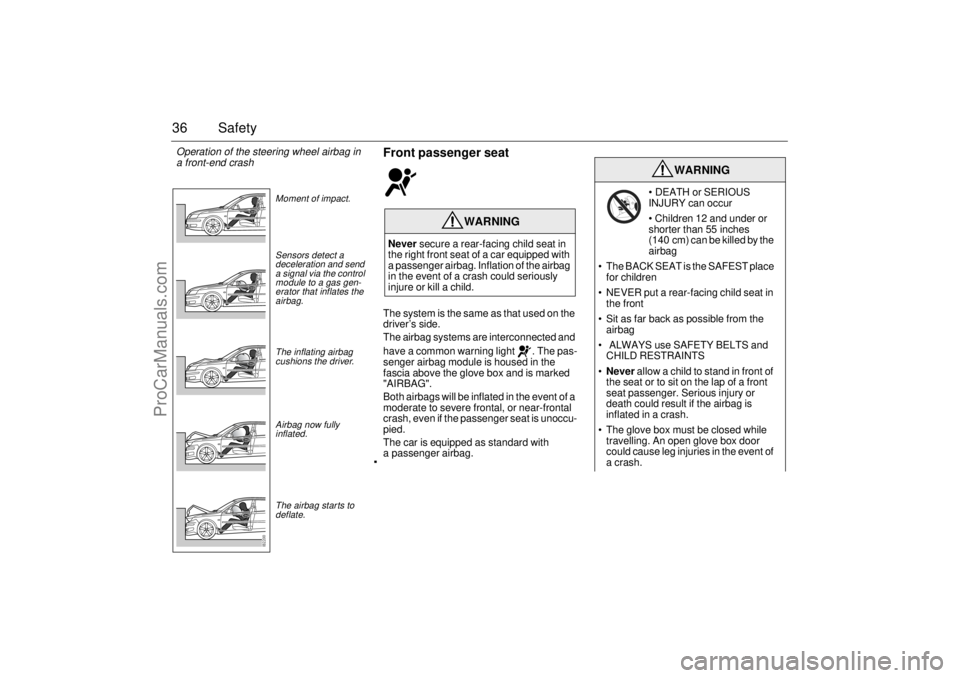
36 Safety
Front passenger seatThe system is the same as that used on the
driver’s side.
The airbag systems are interconnected and
have a common warning light . The pas-
senger airbag module is housed in the
fascia above the glove box and is marked
"AIRBAG".
Both airbags will be inflated in the event of a
moderate to severe frontal, or near-frontal
crash, even if the passenger seat is unoccu-
pied.
The car is equipped as standard with
a passenger airbag.
WARNING
Never secure a rear-facing child seat in
the right front seat of a car equipped with
a passenger airbag. Inflation of the airbag
in the event of a crash could seriously
injure or kill a child.
WARNING
DEATH or SERIOUS
INJURY can occur
Children 12 and under or
shorter than 55 inches
(140 cm) can be killed by the
airbag
The BACK SEAT is the SAFEST place
for children
NEVER put a rear-facing child seat in
the front
Sit as far back as possible from the
airbag
ALWAYS use SAFETY BELTS and
CHILD RESTRAINTS
Never allow a child to stand in front of
the seat or to sit on the lap of a front
seat passenger. Serious injury or
death could result if the airbag is
inflated in a crash.
The glove box must be closed while
travelling. An open glove box door
could cause leg injuries in the event of
a crash.
Operation of the steering wheel airbag in
a front-end crash
Moment of impact.
Sensors detect a
deceleration and send
a signal via the control
module to a gas gen-
erator that inflates the
airbag.
The inflating airbag
cushions the driver.
Airbag now fully
inflated.
The airbag starts to
deflate.
93U S M 06.book Page 36 Friday, February 18, 2005 1:15 PM
ProCarManuals.com
Page 37 of 318

37 Safety
Passenger Sensing SystemVehicles with a passenger sensing system
have indicator LEDs on the facia. The indi-
cators will be lit during the system check.
When the system check is complete, either
the ON or the OFF LED, will be lit. See
Airbag warning light on page 87. If your
vehicle does not have the indicators pic-
tured, then your vehicle does not have the
passenger sensing system.
The passenger sensing system will turn off
the right front passenger’s frontal airbag
under certain conditions.
The driver’s airbag and the side airbags are
not part of the passenger sensing system.
The passenger sensing system works with
sensors that are part of the right front pas-
senger’s seat and safety belt. The sensors
are designed to detect the presence of a
properly-seated occupant and determine if
the passenger’s frontal airbag should be
enabled (may inflate) or not.
Accident statistics show that children are
safer if they are restrained in the rear rather
than the front seat.Saab recommends that child restraints be
secured in a rear seat, including an infant
riding in a rear-facing infant seat, a child
riding in a forward-facing child seat and an
older child riding in a booster seat.
Your vehicle has a rear seat that will accom-
modate a rear-facing child restraint. A label
on your sun visor says, “Never put a rear-
facing child seat in the front.” This is
because the risk to the rear-facing child is so
great, if the airbag deploys. Never place anything on the dash or in
front of the seat as, in addition to being
a hazard to passengers, this could
interfere with the function of the airbag
in the event of a crash. The same
applies to the mounting of accessories
on the dash.
Keep feet on the floor – never put feet
up on the dash, on the seat or out of
the window.
Do not carry anything in your lap.
Passenger Airbag Status Indicator
93U S M 06.book Page 37 Friday, February 18, 2005 1:15 PM
ProCarManuals.com
Page 38 of 318

38 Safety
The passenger sensing system is designed
to turn off the right front passenger’s frontal
airbag if:
the right front passenger seat is unoccu-
pied
the system determines that an infant is
present in a rear-facing infant seat
the system determines that a small child
is present in a forward-facing child
restraint
the system determines that a small child
is present in a booster seat
a right front passenger takes his/her
weight off of the seat for a period of time
the right front passenger seat is occupied
by a smaller person, such as a child who
has outgrown child restraints
or if there is a critical problem with the
airbag system or the passenger sensing
system.When the passenger sensing system has
turned off the passenger’s frontal air bag,
the off indicator will light and stay lit to
remind you that the airbag is off.
If a child restraint has been installed and the
on indicator is lit, turn the vehicle off.
Remove the child restraint from the vehicle
and reinstall the child restraint following the
child restraint manufacturer’s directions and
refer to Installation of child restraint using
the standard safety belt on page 31.
If after reinstalling the child restraint and
restarting the vehicle, the on indicator is still
lit, check to make sure that the vehicle’s
seatback is not pressing the child restraint
into the seat cushion. If this happens,
slightly recline the vehicle’s seatback and
adjust the seat cushion if possible. Also
make sure the child restraint is not trapped
under the vehicle head restraint. If this hap-
pens, adjust the head restraint.
If the on indicator is still lit, secure the child
in the child restraint in a rear seat position in
the vehicle and check with your dealer.
WARNING
A child in a rear-facing child restraint can
be seriously injured or killed if the right
front passenger’s airbag inflates. This is
because the back of the rear-facing child
restraint would be very close to the inflat-
ing airbag.
Even though the passenger sensing
system is designed to turn off the passen-
ger’s frontal airbag if the system detects a
rear-facing child restraint, no system is
fail-safe, and no one can guarantee that
an airbag will not deploy under some
unusual circumstance, even though it is
turned off. Saab recommends that rear-
facing child restraints be secured in the
rear seat, even if the airbag is off.93U S M 06.book Page 38 Friday, February 18, 2005 1:15 PM
ProCarManuals.com
Page 39 of 318
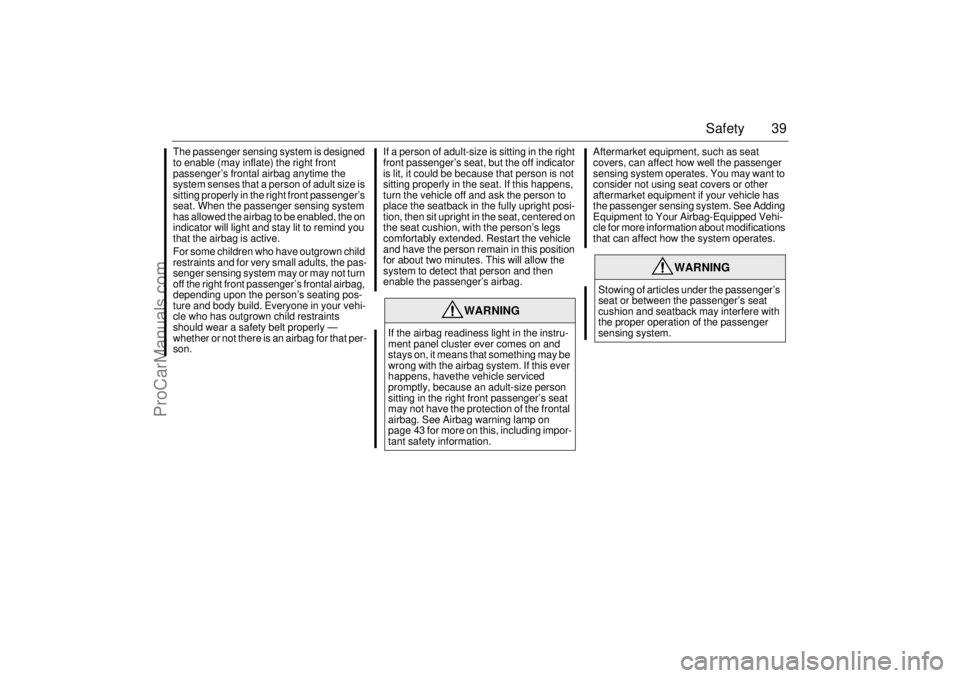
39 Safety
The passenger sensing system is designed
to enable (may inflate) the right front
passenger’s frontal airbag anytime the
system senses that a person of adult size is
sitting properly in the right front passenger’s
seat. When the passenger sensing system
has allowed the airbag to be enabled, the on
indicator will light and stay lit to remind you
that the airbag is active.
For some children who have outgrown child
restraints and for very small adults, the pas-
senger sensing system may or may not turn
off the right front passenger’s frontal airbag,
depending upon the person’s seating pos-
ture and body build. Everyone in your vehi-
cle who has outgrown child restraints
should wear a safety belt properly —
whether or not there is an airbag for that per-
son.If a person of adult-size is sitting in the right
front passenger’s seat, but the off indicator
is lit, it could be because that person is not
sitting properly in the seat. If this happens,
turn the vehicle off and ask the person to
place the seatback in the fully upright posi-
tion, then sit upright in the seat, centered on
the seat cushion, with the person’s legs
comfortably extended. Restart the vehicle
and have the person remain in this position
for about two minutes. This will allow the
system to detect that person and then
enable the passenger’s airbag.Aftermarket equipment, such as seat
covers, can affect how well the passenger
sensing system operates. You may want to
consider not using seat covers or other
aftermarket equipment if your vehicle has
the passenger sensing system. See Adding
Equipment to Your Airbag-Equipped Vehi-
cle for more information about modifications
that can affect how the system operates.
WARNING
If the airbag readiness light in the instru-
ment panel cluster ever comes on and
stays on, it means that something may be
wrong with the airbag system. If this ever
happens, havethe vehicle serviced
promptly, because an adult-size person
sitting in the right front passenger’s seat
may not have the protection of the frontal
airbag. See Airbag warning lamp on
page 43 for more on this, including impor-
tant safety information.
WARNING
Stowing of articles under the passenger’s
seat or between the passenger’s seat
cushion and seatback may interfere with
the proper operation of the passenger
sensing system.
93U S M 06.book Page 39 Friday, February 18, 2005 1:15 PM
ProCarManuals.com
Page 40 of 318
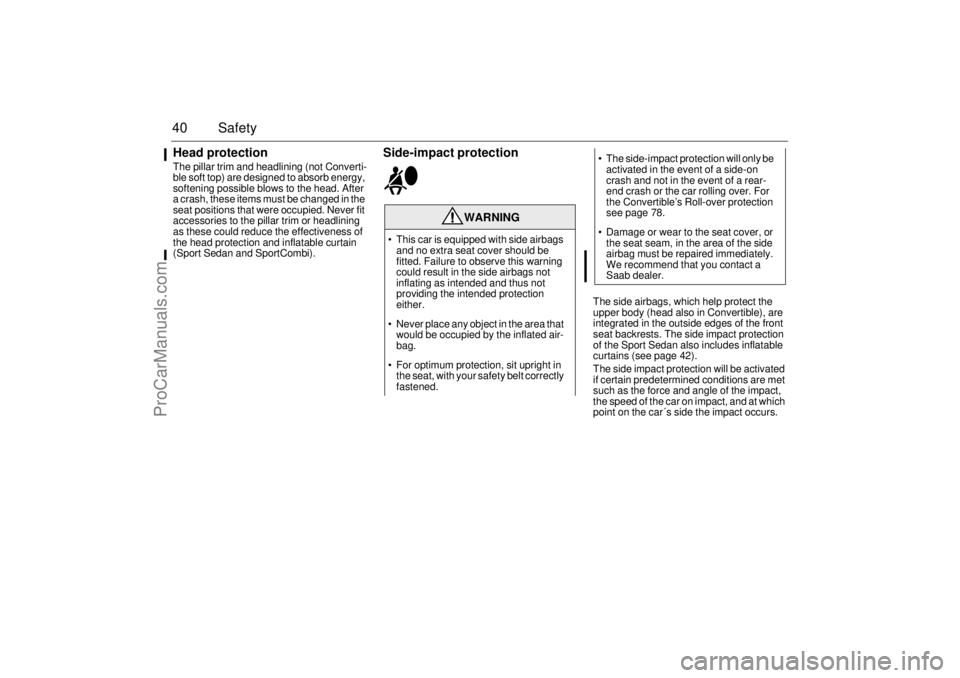
40 SafetyHead protectionThe pillar trim and headlining (not Converti-
ble soft top) are designed to absorb energy,
softening possible blows to the head. After
a crash, these items must be changed in the
seat positions that were occupied. Never fit
accessories to the pillar trim or headlining
as these could reduce the effectiveness of
the head protection and inflatable curtain
(Sport Sedan and SportCombi).
Side-impact protection
The side airbags, which help protect the
upper body (head also in Convertible), are
integrated in the outside edges of the front
seat backrests. The side impact protection
of the Sport Sedan also includes inflatable
curtains (see page 42).
The side impact protection will be activated
if certain predetermined conditions are met
such as the force and angle of the impact,
the speed of the car on impact, and at which
point on the car´s side the impact occurs.
WARNING
This car is equipped with side airbags
and no extra seat cover should be
fitted. Failure to observe this warning
could result in the side airbags not
inflating as intended and thus not
providing the intended protection
either.
Never place any object in the area that
would be occupied by the inflated air-
bag.
For optimum protection, sit upright in
the seat, with your safety belt correctly
fastened.
The side-impact protection will only be
activated in the event of a side-on
crash and not in the event of a rear-
end crash or the car rolling over. For
the Convertible’s Roll-over protection
see page 78.
Damage or wear to the seat cover, or
the seat seam, in the area of the side
airbag must be repaired immediately.
We recommend that you contact a
Saab dealer.
93U S M 06.book Page 40 Friday, February 18, 2005 1:15 PM
ProCarManuals.com